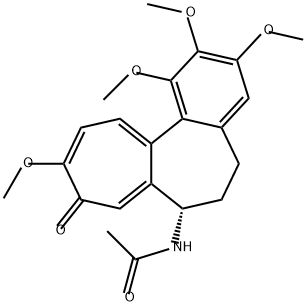Description
Colchicin is a kind of alkaloid extracted from the crom or seed of the lily family plants, Colchicum autumnale, and is naturally presented in the Liliaceae Garland and Iphigenia with the contents being 0.11% and 0.1%. It is pale yellow needle crystals. It has slight odor and bitter taste with the melting point being 157℃. It is soluble in cold water, alcohol, chloroform and formaldehyde with poor solubility in hot water and is not easily soluble in benzene and ether.
Physical properties
Colchicin appears as odorless or nearly odorless pale yellow needles or powder that darkens on exposure to light.
Uses
Colchicin is an alkaloid drug derived from a plant belonging to the Lily family, known as Colchicum autumnale, or "autumn crocus."Colchicine is used in the treatment of gout flares and Familial Mediterranean fever, and prevention of major cardiovascular events.
Biological Functions
Colchicin interacts with albumin and binds to tubulin. Its association with tubulin impacts autophagic vacuole fusion with lysosomes. It inhibits tyrosine kinases and phospholipases. Colchicin may be useful for treating acute coronary syndromes. It is prescribed for treating rheumatologic conditions including familial mediterranean fever (FMF) and acute gouty arthritis.
Hazard
Colchicin poisoning has a certain incubation period with symptoms often happening at 3d~6d after oral administration or injection. Symptoms include throat burning, nausea, vomiting, abdominal pain, diarrhea, watery stools, hematuria, urine retention, numbness, aching limbs, muscle cramps, hair loss, dilated pupils, and convulsion, paralysis of the central nervous system, and respiratory depression and death. In addition, it can also produce local reactions such as when the drug liquid is leaked out from the blood vessel upon injection, local tissue necrosis can occur. Poisoning is usually caused by ingestion or drug overdose.
Health Hazard
Main risks and target organs: Colchicin exerts a multiorgan toxicity. The main toxic effects are related to the effects of colchicine on cellular division and account for diarrhea, bone marrow depression, alopecia. Other acute effects are hypovolemia, shock, and coagulation disturbances, which may lead to death.
Physiological effects
Colchicin ameliorates the symptoms of gout and Familial Mediterranean fever. It possesses anti-inflammatory, anti-fibrotic, and cardiovascular protective effects. Colchicin was shown to exhibit anticancer properties, such as the inhibition of cancer cell migration and angiogenesis.
Metabolism
Colchicin undergoes some hepatic metabolism. Colchicin is partially deacetylated in the liver. Large amounts of colchicin and of its metabolites undergo enterohepatic circulation. This may explain the occurrence of a second plasma peak concentration observed 5 to 6 hours after ingestion.
Toxicity
The human lethal dose of colchicine is 6mg~7mg. Mouse oral-LD was 66.6mg/kg; LD50-intraperitoneal injection of mice is 3.5mg/kg. LD50-subcutaneous injection of rat is 4mg/kg.



